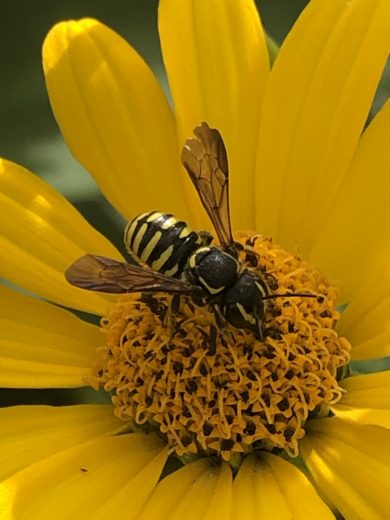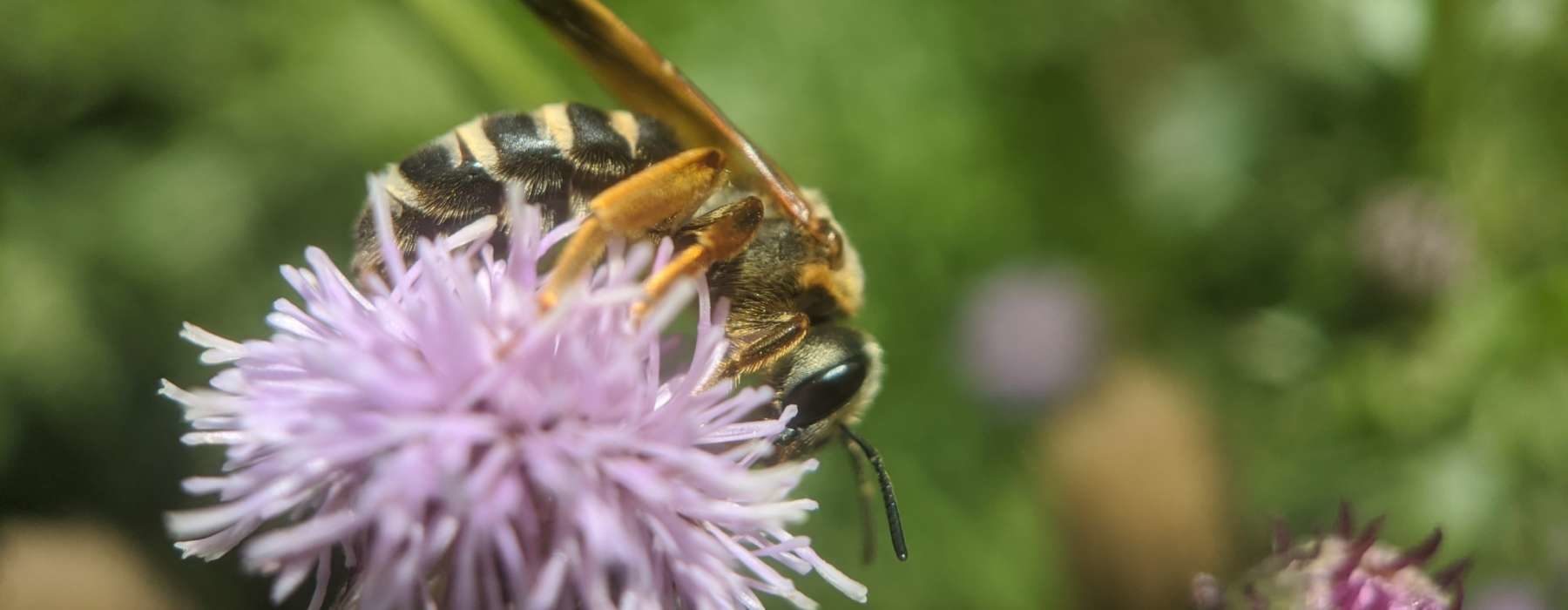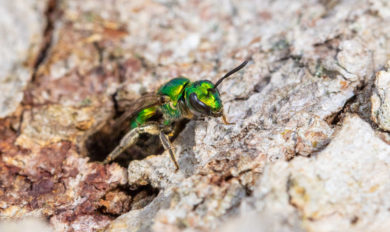The Vermont Atlas of Life Wild Bee Survey has added about 50 new bee species to the state checklist over the last two years and will likely find many more as field surveys continue and historic collections are closely examined. The Vermont Wild Bee Survey (VTBees) is the first step for understanding the conservation status of the entire Vermont bee fauna. You can help too! Join our survey. It’s as easy as snapping a photo with your smartphone. Learn more on our VTBees website.
Bees of all shapes and sizes create a gently humming backdrop to many landscapes, some catching people’s eyes as they zip along. While some people may react to them in fear, bees play an indispensable role in many ecosystems. Without bees and other pollinators, the world’s flora would look starkly different. Nearly 90% of flowering plant species, including 75% of agricultural crops, benefit from animal pollination. The United States alone grows more than 100 crops that either need or benefit from bee pollination, and the economic value of these native pollinators is estimated at $3 billion per year.
In 2019, VTBees began the first phase of this project by focusing on Chittenden County and completing survey efforts that stretched from the shoreline of Lake Champlain to the alpine summit of Mount Mansfield. Twelve priority survey blocks in Chittenden County received significant coverage by project biologists and 11 dedicated community scientists who ‘adopted’ 9 of the survey blocks and sampled at 3 unique sites 4 to 5 times throughout the season. Staff field technicians and biologists repeated 60 roadside bumble bee survey stations in Chittenden and Windsor counties that were first completed in 2012-2014 during the Vermont Bumble Bee Atlas. Additionally, the UVM GUND partnered with VTBees and conducted bee bowl surveys on four solar field sites in the towns of Milton, Shelburne, Ferrisburgh and Middlebury. We also had 284 volunteers photograph and share 2,405 bee observations on the Vermont Atlas of Life on iNaturalist project in 2019. This represented 61 confirmed species (many confirmations were done by world expert John Ascher and VCE’s Spencer Hardy).
In 2020, we tailored our fieldwork to comply with the COVID-19 pandemic safety and rules to continue to produce data that would help us in assessing the conservation status of wild bees in Vermont. We developed important collaborations with regional partners, including Green Mountain National Forest, Merck Forest and Farmland Center, USFWS, and others. These partnerships increased our capacity and the impact of our work by providing bee data that would otherwise be expensive and impractical for them to collect independently and during a pandemic.

Sunflower Burrowing-Resin Bee (Paranthidium jugatorium) first discovered in Vermont by Kevin Hemeon.
With a concerted effort to recruit people to survey their backyards and neighborhoods during COVID-19 restrictions, we had 530 volunteers photograph and share 5,007 bee observations on the Vermont Atlas of Life on iNaturalist project in 2020, doubling 2019 numbers. This represented 85 confirmed species (again, many confirmations were done by Dr. John Ascher and Spencer Hardy), one was a new species for Vermont. The Sunflower Burrowing-Resin Bee (Paranthidium jugatorium) was discovered and photographed by a volunteer in sw Vermont and verified by John Ascher. This is a significant extension of its range northward in northeastern North America.
Even with some of our 2020 and 2021 specimens, as well as historic insect collections still awaiting identification to species for us to compile a complete list, there are already surprising results documenting substantial range expansions and the continued survival of several very rare species.
So far, we’ve added at least 15 new species for Vermont from our 2020 field work alone. Coupled with our previous work in 2019, we’ve now discovered nearly 50 new species for Vermont. And we didn’t have to go far from our homes to make new bee discoveries during the pandemic.
Visiting a Montpelier backyard where he was staying, Spencer Hardy, our lead project biologist, turned up Vermont’s first record of the Constrained Cuckoo Carder Bee (Stelis coarctatus). This species is a nest parasite of resin bees (Heriades), which nest in old beetle holes in dead wood. By leaving a pile of logs and brush in their backyard, the homeowners may have unintentionally created perfect habitat for both of these native bees.
Colla et al. (2012) analysed all 770 species of bees known from eastern North America, and found only 37 species that had not been documented between 1990 and 2010. Amazingly, two of these species were discovered by VTBees. The Canadian Cellophane-cuckoo Bee (Epeolus canadensis) was found in Colchester. The Sixteen-spotted Cuckoo Carder Bee (Stelis permaculata) was collected by Leif Richardson in August 2007 in Cornwall Swamp WMA and remained unidentified in his collection until now. Additionally, we confirmed the leafcutter bee, Megachile rugifrons, a G2 ranked species, from Addison County malaise trap in 2019 and a 1995 Rutland County specimen in a private collection, which are the only known New England records. This species could be described as a prairie species with Great Lakes and coastal plain extensions (NatureServe Explorer 2020). The Splendid Sweat Bee (Agapostemon splendens) is a sand specialist that so far has been found only in a few Winooski River sand deposits. It occurs broadly across North America from the Rocky Mountains east to the Atlantic coast and is limited by the availability of deep sand, which it needs as a substrate for excavating its nests. Ground-cherry Perdita (Perdita halictoides) is a Physalis (genus of flowering plants in the nightshade family; Solanaceae) specialist and requires sand for nesting. It is primarily known from the midwest. We found it to be abundant in a crop row of Tomatillos at the Intervale Community Farm, but has not been found anywhere else in the state.
We have documented 13 introduced bee species in Vermont. These species could compete with native bees for food and nesting areas. It has long been believed that cultivated and escaped Western Honeybee (Apis mellifera) colonies compete with native pollinators for food resources (Valido et al. 2019) and can spread disease (Alger et al. 2019). Recently, LeCroy et al. (2019) found that two species of mason bees recently established in the mid-Atlantic region U.S., one which now occurs in Vermont (Osmia cornifrons), may be responsible for declines of native bee species, perhaps from disease spillover and competition. All native species showed substantial annual declines, resulting in cumulative catch losses ranging 76–91% since 2003.
Introduced bee species documented in Vermont.
| Common Name | Scientific Name |
| Wilke’s Mining Bee | Andrena wilkella |
| European Wool Carder Bee | Anthidium manicatum |
| Oblong Woolcarder Bee | Anthidium oblongatum |
| Western Honey Bee | Apis mellifera |
| Rampion Scissor Bee | Chelostoma rapunculi |
| Slender-faced Masked Bee | Hylaeus leptocephalus |
| White-zoned Furrow Bee | Lasioglossum leucozonium |
| Patchwork Leafcutter Bee | Megachile centuncularis |
| Alfalfa Leafcutter Bee | Megachile rotundata |
| Sculptured Resin Bee | Megachile sculpturalis |
| Hornfaced Bee | Osmia cornifrons |
| Taurus Mason Bee | Osmia taurus |
| Viper’s Bugloss Small-Mason Bee | Hoplitis anthocopoides |
There are certainly more species that have avoided detection. For example, there are two genera that have been collected in most of our neighboring states that we are going to make a concerted effort to find. The genus Mellita contains three rare species in the Northeast, all of which are pollen specialists, including one that requires Deerberry (Vaccinium stamineum), which occurs sporadically in southern Vermont. The Southeastern Blueberry Bee (Habropoda laboriosa) is another Vaccinium specialist that likely reaches the northern extreme of its range in southern Vermont.
Our work has bolstered the checklist of Vermont bees to 324 species in 36 genera. With many more specimens to identify from previous field seasons and historic collections, coupled with targeted field work in 2021; we now estimate that there are likely more than 350 wild bee species in Vermont. With our knowledge of wild bees and their conservation in Vermont in its infancy, the information we garner over the next year will help serve as a guide for research and conservation strategies for these amazing insects far into the Anthropocene.
You can help too! Join our survey. It’s as easy as snapping a photo with your smartphone. Learn more on our VTBees website.
Some of the new bee species documented in Vermont by VTBees project.
| Scientific Name | Common Name |
| Andrena braccata | |
| Andrena distans | Cranesbill Miner |
| Andrena erythronii | Trout-lily Mining Bee |
| Andrena ceanothi | Ceanothus Miner Bee |
| Andrena ziziaeformis | |
| Ceratina strenua | Nimble Carpenter Bee |
| Coelioxys modestus | Modest Cuckoo Leaf-cutter Bee |
| Coelioxys octodentatus | Eight-toothed Cuckoo Leaf-cutter Bee |
| Colletes solidaginis | Goldenrod Cellophane Bee |
| Colletes americanus | |
| Epeolus bifasciatus | Two-banded Cellophane-Cuckoo |
| Epeolus canadensis | Canadian Cellophane-cuckoo Bee |
| Halictus parallelus | Parallel-striped Sweat Bee |
| Hoplitis anthocopoides | Viper’s Bugloss Small-Mason |
| Hoplitis pilosifrons | Hairy-fronted Small-Mason |
| Hoplitis truncata | Truncate Small-Mason |
| Hylaeus nelumbonis | Nelumbo Masked Bee |
| Lasioglossum abanci | |
| Lasioglossum fuscipenne | Dark-winged Sweat Bee |
| Lasioglossum gotham | Gotham Sweat Bee |
| Lasioglossum oenotherae | Evening Primrose Sweat Bee |
| Lasioglossum platyparium | |
| Lasioglossum timothyi | Timothy’s Sweat Bee |
| Lasioglossum weemsi | Weems’s Sweat Bee |
| Megachile rugifrons | Rugose-fronted Resin Bee |
| Melissodes apicatus | Pickerelweed Long-horned Bee |
| Melissodes bimaculatus | Two-spotted Long-horned Bee |
| Nomada denticulata | Denticulate Cuckoo Nomad Bee |
| Nomada tiftonensis | Tifton Nomad Bee |
| Nomada xanthura | Yellow-striped Cuckoo Nomad Bee |
| Osmia georgica | Georgia Mason |
| Osmia taurus | Taurus Mason Bee |
| Osmia virga | |
| Paranthidium jugatorium | Sunflower Burrowing-Resin Bee |
| Stelis coarctatus | Constrained Cuckoo Carder Bee |
| Stelis permaculata | Sixteen-spotted Cuckoo Carder Bee |








